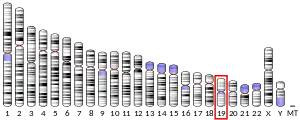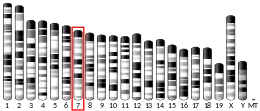ATP1A3
Sodium/potassium-transporting ATPase subunit alpha-3 is an enzyme that in humans is encoded by the ATP1A3 gene.[5][6]
Function
The protein encoded by this gene belongs to the family of P-type cation transport ATPases, and to the subfamily of Na+/K+-ATPases. Na+/K+-ATPase is an integral membrane protein responsible for establishing and maintaining the electrochemical gradients of Na and K ions across the plasma membrane. These gradients are essential for osmoregulation, for sodium-coupled transport of a variety of organic and inorganic molecules, and for electrical excitability of nerve and muscle. This enzyme is composed of two subunits, a large catalytic subunit (alpha) and a smaller glycoprotein subunit (beta). The catalytic subunit of Na+/K+-ATPase is encoded by multiple genes. This gene encodes an alpha 3 subunit.[6]
Clinical significance
Disease causing variants of the ATP1A3 gene are known to cause a variety of movement disorders and epilepsies.[7] The known associations include a variety of syndromes:
1) Alternating hemiplegia of childhood (AHC)
2) Rapid onset dystonia-parkinsonism (RDP, also known as DYT12)
3) Cerebellar ataxia, Areflexia, Pes cavus, Optic atrophy and Sensorineural hearing loss (CAPOS/CAOS syndrome)
4) Developmental and epileptic encephalopathy
5) Fever induced paroxysmal weakness and encephalopathy (FIPWE)
6) Recurrent episodes of cerebellar ataxia (RECA)
7) Very early-onset schizophrenia [8]
In mice, mutations in this gene are associated with epilepsy. By manipulating this gene in the offspring of such mice, epilepsy can be avoided.[9]
References
- GRCh38: Ensembl release 89: ENSG00000105409 - Ensembl, May 2017
- GRCm38: Ensembl release 89: ENSMUSG00000040907 - Ensembl, May 2017
- "Human PubMed Reference:". National Center for Biotechnology Information, U.S. National Library of Medicine.
- "Mouse PubMed Reference:". National Center for Biotechnology Information, U.S. National Library of Medicine.
- Brashear A, Dobyns WB, de Carvalho Aguiar P, Borg M, Frijns CJ, Gollamudi S, Green A, Guimaraes J, Haake BC, Klein C, Linazasoro G, Münchau A, Raymond D, Riley D, Saunders-Pullman R, Tijssen MA, Webb D, Zaremba J, Bressman SB, Ozelius LJ (Mar 2007). "The phenotypic spectrum of rapid-onset dystonia-parkinsonism (RDP) and mutations in the ATP1A3 gene". Brain. 130 (Pt 3): 828–35. doi:10.1093/brain/awl340. PMID 17282997.
- "Entrez Gene: ATP1A3 ATPase, Na+/K+ transporting, alpha 3 polypeptide".
- Papandreou A, Danti FR, Spaull R, Leuzzi V, Mctague A, Kurian MA (February 2020). "The expanding spectrum of movement disorders in genetic epilepsies". Developmental Medicine and Child Neurology. 62 (2): 178–191. doi:10.1111/dmcn.14407. PMID 31784983. S2CID 208498567.
- Smedemark-Margulies N, Brownstein CA, Vargas S, Tembulkar SK, Towne MC, Shi J, Gonzalez-Cuevas E, Liu KX, Bilguvar K, Kleiman RJ, Han MJ, Torres A, Berry GT, Yu TW, Beggs AH, Agrawal PB, Gonzalez-Heydrich J (September 2016). "A novel de novo mutation in ATP1A3 and childhood-onset schizophrenia". Cold Spring Harb Mol Case Stud. 2 (5): a001008. doi:10.1101/mcs.a001008. PMC 5002930. PMID 27626066.
- Clapcote SJ, Duffy S, Xie G, Kirshenbaum G, Bechard AR, Rodacker Schack V, Petersen J, Sinai L, Saab BJ, Lerch JP, Minassian BA, Ackerley CA, Sled JG, Cortez MA, Henderson JT, Vilsen B, Roder JC (August 2009). "Mutation I810N in the alpha3 isoform of Na+,K+-ATPase causes impairments in the sodium pump and hyperexcitability in the CNS". Proc. Natl. Acad. Sci. U.S.A. 106 (33): 14085–90. Bibcode:2009PNAS..10614085C. doi:10.1073/pnas.0904817106. PMC 2729024. PMID 19666602.
Further reading
- Lingrel JB, Orlowski J, Shull MM, Price EM (1990). "Molecular genetics of Na,K-ATPase". Prog. Nucleic Acid Res. Mol. Biol. Progress in Nucleic Acid Research and Molecular Biology. 38: 37–89. doi:10.1016/S0079-6603(08)60708-4. ISBN 978-0-12-540038-1. PMID 2158121.
- Sverdlov ED, Monastyrskaia GS, Broude NE, Ushkarev IuA, Melkov AM (1988). "The family of human Na+,K+-ATPase genes. Structure of the gene for isozyme alphaII" [The family of human Na+,+-ATPase genes. Structure of the gene for isozyme alphaII]. Doklady Akademii Nauk SSSR. 297 (6): 1488–94. PMID 2834163.
- Monastyrskaya GS, Broude NE, Melkov AM, Malyshev IV, Allikmets RL, Kostina MB, Dulubova IE (1988). "Family of human Na+, K+-ATPase genes. Structure of the gene for the catalytic subunit (alpha III-form) and its relationship with structural features of the protein". FEBS Lett. 233 (1): 87–94. doi:10.1016/0014-5793(88)81361-9. PMID 2838329. S2CID 1378625.
- Yang-Feng TL, Schneider JW, Lindgren V, Shull MM, Benz EJ, Lingrel JB, Francke U (1988). "Chromosomal localization of human Na+, K+-ATPase alpha- and beta-subunit genes". Genomics. 2 (2): 128–38. doi:10.1016/0888-7543(88)90094-8. PMID 2842249.
- Sverdlov ED, Broude NE, Sverdlov VE, Monastyrskaya GS, Grishin AV, Petrukhin KE, Akopyanz NS, Modyanov NN (1987). "Family of Na+,K+-ATPase genes. Intra-individual tissue-specific restriction fragment length polymorphism". FEBS Lett. 221 (1): 129–33. doi:10.1016/0014-5793(87)80366-6. PMID 2887455. S2CID 32756405.
- Harley HG, Brook JD, Jackson CL, Glaser T, Walsh KV, Sarfarazi M, Kent R, Lager M, Koch M, Harper PS (1989). "Localization of a human Na+,K+-ATPase alpha subunit gene to chromosome 19q12----q13.2 and linkage to the myotonic dystrophy locus". Genomics. 3 (4): 380–4. doi:10.1016/0888-7543(88)90131-0. PMID 2907504.
- Monastyrskaya GS, Broude NE, Allikmets RL, Melkov AM, Malyshev IV, Dulubova IE, Petrukhin KE (1987). "The family of human Na+,K+-ATPase genes. A partial nucleotide sequence related to the alpha-subunit". FEBS Lett. 213 (1): 73–80. doi:10.1016/0014-5793(87)81467-9. PMID 3030810. S2CID 35674738.
- Shull MM, Lingrel JB (1987). "Multiple genes encode the human Na+,K+-ATPase catalytic subunit". Proc. Natl. Acad. Sci. U.S.A. 84 (12): 4039–43. Bibcode:1987PNAS...84.4039S. doi:10.1073/pnas.84.12.4039. PMC 305017. PMID 3035563.
- Sverdlov ED, Monastyrskaya GS, Broude NE, Allikmets RL, Melkov AM, Malyshev IV, Dulobova IE, Petrukhin KE (1987). "The family of human Na+,K+-ATPase genes. No less than five genes and/or pseudogenes related to the alpha-subunit". FEBS Lett. 217 (2): 275–8. doi:10.1016/0014-5793(87)80677-4. PMID 3036582. S2CID 44449386.
- Maruyama K, Sugano S (1994). "Oligo-capping: a simple method to replace the cap structure of eukaryotic mRNAs with oligoribonucleotides". Gene. 138 (1–2): 171–4. doi:10.1016/0378-1119(94)90802-8. PMID 8125298.
- Suzuki Y, Yoshitomo-Nakagawa K, Maruyama K, Suyama A, Sugano S (1997). "Construction and characterization of a full length-enriched and a 5'-end-enriched cDNA library". Gene. 200 (1–2): 149–56. doi:10.1016/S0378-1119(97)00411-3. PMID 9373149.
- Kramer PL, Mineta M, Klein C, Schilling K, de Leon D, Farlow MR, Breakefield XO, Bressman SB, Dobyns WB, Ozelius LJ, Brashear A (1999). "Rapid-onset dystonia-parkinsonism: linkage to chromosome 19q13". Ann. Neurol. 46 (2): 176–82. doi:10.1002/1531-8249(199908)46:2<176::AID-ANA6>3.0.CO;2-2. PMID 10443882.
- Esplin MS, Fausett MB, Faux DS, Graves SW (2003). "Changes in the isoforms of the sodium pump in the placenta and myometrium of women in labor". Am. J. Obstet. Gynecol. 188 (3): 759–64. doi:10.1067/mob.2003.166. PMID 12634653.
- de Carvalho Aguiar P, Sweadner KJ, Penniston JT, Zaremba J, Liu L, Caton M, Linazasoro G, Borg M, Tijssen MA, Bressman SB, Dobyns WB, Brashear A, Ozelius LJ (2004). "Mutations in the Na+/+-ATPase alpha3 gene ATP1A3 are associated with rapid-onset dystonia parkinsonism". Neuron. 43 (2): 169–75. doi:10.1016/j.neuron.2004.06.028. PMID 15260953. S2CID 15874616.
- Benfante R, Antonini RA, Vaccari M, Flora A, Chen F, Clementi F, Fornasari D (2005). "The expression of the human neuronal α3 Na+,K+-ATPase subunit gene is regulated by the activity of the Sp1 and NF-Y transcription factors". Biochem. J. 386 (Pt 1): 63–72. doi:10.1042/BJ20041294. PMC 1134767. PMID 15462673.
- Lim J, Hao T, Shaw C, Patel AJ, Szabó G, Rual JF, Fisk CJ, Li N, Smolyar A, Hill DE, Barabási AL, Vidal M, Zoghbi HY (2006). "A protein-protein interaction network for human inherited ataxias and disorders of Purkinje cell degeneration". Cell. 125 (4): 801–14. doi:10.1016/j.cell.2006.03.032. PMID 16713569. S2CID 13709685.
External links
- GeneReview/NCBI/NIH/UW entry on Rapid-Onset Dystonia Parkinsonism
- Human ATP1A3 genome location and ATP1A3 gene details page in the UCSC Genome Browser.




